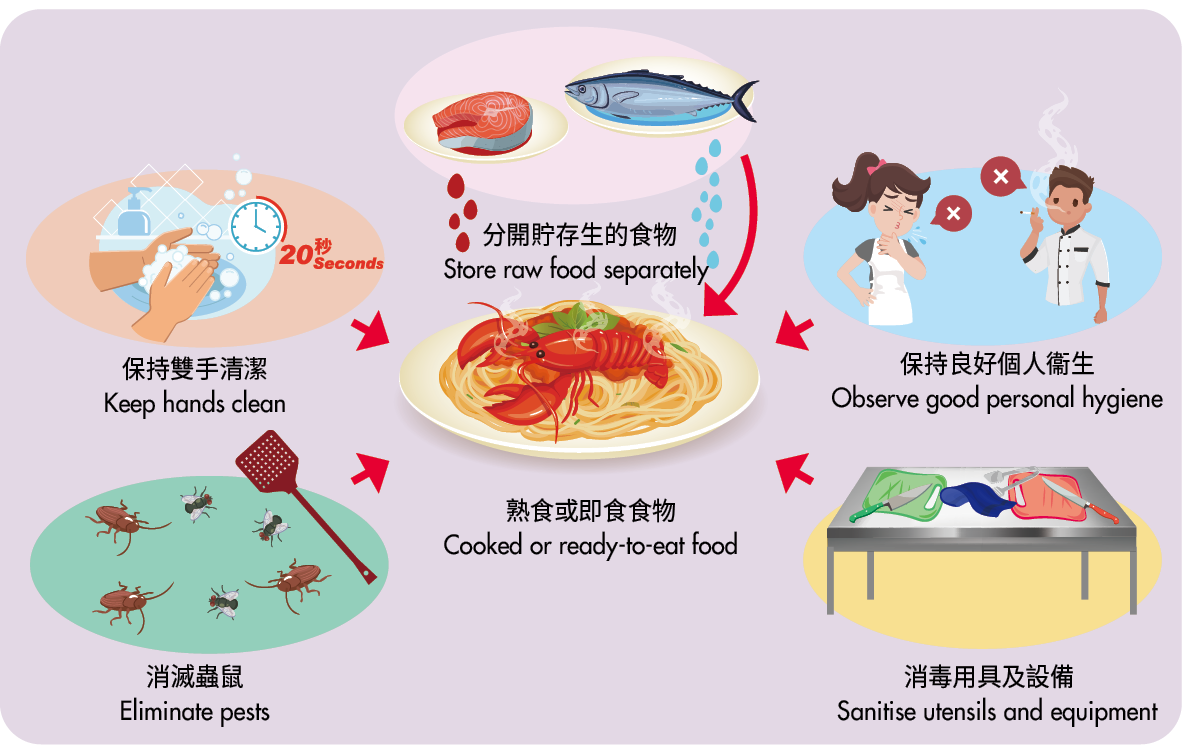
Food Safety Focus (171st Issue, October 2020) – Incident in Focus
More About Cross-contamination of Food and How We Can Avoid It
Reported by Mr. Chi Keung SO, Chief Health Inspector,
Risk Communication Section, Centre for Food Safety
Background
Nineteen people from seven groups suffered from gastrointestinal symptoms after consuming lobsters with E-fu noodles baked in soup from a restaurant in Tuen Mun in September 2020. Vibrio parahaemolyticus, a bacterium that lives naturally in sea water, was the causative agent of the food poisoning cases. Investigations revealed that the food handlers who picked raw seafood also handled cooked ingredients with the same pair of gloves. They also dried their hands with the same towels for cleaning the work table. The work table was used to handle both raw seafood and cooked food simultaneously. As a result, cross-contamination is the most likely contributing factor to these food poisoning cases. In fact, cross-contamination is one of the often overlooked but preventable factors for food poisoning.
 Figure 1: Avoid cross-contamination
Figure 1: Avoid cross-contamination
Cross-contamination as Means of Spreading Food Poisoning Organisms
Cross-contamination refers to the transfer of microorganisms from one vehicle, such as food (especially raw), utensils and hands of food handlers, to another food. There are two ways of how cross-contamination may occur. On the one hand, bacteria can be transferred directly when one food touches or drips onto another. On the other hand, bacteria can be transferred indirectly from contaminated hands, pest droppings, food preparation equipment and utensils, work surfaces or even splashes to food.
Aggravating Factors
Many food premises in Hong Kong have small kitchens. Tight food preparation areas, compound with the provision of a vast varieties of dishes and high volume of output during rush hours, may lead to slippage in food safety practices during food preparation. This can aggravate the risk of cross-contamination to ready-to-eat food. Despite all the constraints, food premises operators can follow some basic and effective steps to avoid cross-contamination.
Basic Steps to Avoid Cross-contamination
During food preparation, food handlers should always wash their hands thoroughly, especially after touching raw food or its packaging and right before handling cooked/ready-to-eat food. Wash hands with liquid soap and water, and rub for at least 20 seconds. Then rinse with water and dry with a disposable paper towel. Wear disposable gloves when handling read-to-eat food. They should be changed when damaged or soiled, such as after touching raw food in the case reported above. Remember, wearing disposable gloves cannot replace proper hand hygiene.
Effective cleaning and disinfection of food preparation equipment and cooking utensils are equally important. There should be separate zones/tables for handling raw and cooked/ready-to-eat food. However, should the same work table be used for both, the worktop must be thoroughly cleaned and disinfected before being used for cooked/ready-to-eat food. Wash utensils and worktops with hot water and detergent or approved types of bactericidal agent, especially after preparing raw food.
Furthermore, if raw food and cooked/ready-to-eat food have to be stored in the same refrigerator, store food in covered containers to avoid contact between raw food and cooked/ready-to-eat food. Store raw food below cooked/ready-to-eat food in the refrigerator to prevent cross-contamination through drippings. In guarding against pest contamination, store cooked/ready-to-eat food out of reach from pests. A pest control programme should also be in place to eliminate this source of contamination.
Key Points to Note
- Cross-contamination can occur directly by raw food touching or dripping onto cooked/ready-to-eat food, or indirectly via contaminated hands, pests, work surfaces, food preparation equipment and utensils.
- Cross-contamination is preventable with the application of some basic hygienic practices.
Advice to Consumers
- Observe the same basic steps to avoid cross-contamination, as the risk of cross-contamination also exists in domestic environment.
- Separate raw food, e.g. raw meat, poultry and seafood, from cooked/ready-to-eat food. Store raw food below cooked/ready-to-eat food in the refrigerator in separate covered containers.
- Purchase cooked/ready-to-eat food from reliable sources.
Advice to the Trade
- The management should provide training to food handlers so that they can fully understand the risk of cross-contamination in handling raw food and observe good personal hygiene to prevent cross-contamination.
- Review the food preparation work flow to identify the risk of cross-contamination and design a food safety plan to eliminate the risk.
-
Always adhere to the “5 Keys to Food Safety”, especially the keys of “Clean” and “Separate” to safeguard against cross-contamination for the preparation of food.

